Chick-fil-A is an American favorite, famously known for its chicken sandwiches and waffle fries. You might also have supported the company because of its antibiotic-free promise, but that’s changing now.
Recently, Chick-fil-A stated that they are switching from No Antibiotics Ever (NAE) chicken to No Antibiotics Important to Human Medicine (NAIHM) chickens. NAE means that no antibiotics were used at all when the chickens were raised. On the other hand, NAIHM means that antibiotics are only allowed if the animals are sick or were part of a flock where illness was rampant.
This doesn’t mean that Chick-fil-A is going to start going out of its way to source any chickens they can find, but they are willing to use meat from chickens that were treated with antibiotics if they needed them. There won’t be any typical drugs like amoxicillin or erythromycin, which are often used to treat human infections like pneumonia, but only antibiotics that are appropriate for use on animals. This, understandably, still has sparked public concern.
Dating back decades, there’s been growing concern about antibiotic overuse in animal products. Earlier in the 2000s, research suggested that 80 percent of all antibiotics sold in the United States were specifically for animal agriculture, and close to 70 percent of those were antibiotics important for treating human illness.

Researchers have been tirelessly studying the connections for years, finding that there is evidence to suggest that regularly consuming poultry and meat that have been treated with human antibiotics can be a factor in antibiotic resistance. This refers to the body’s ability to build up a tolerance to medications. It means that if you become sick and take certain antibiotics, they may not work. Obviously, this could have significant public health repercussions.
Consumers started to speak up, leading to more media coverage of the issue and prompting companies like Chick-fil-A to step in. In 2014, Chick-fil-A made a statement that, by 2019, they wanted to shift all of their served chicken to NAE. It was the largest franchise to implement such a bold move, but that’s changing slightly now.
If this makes you weary as a consumer, it’s best to know that nothing else is really changing. Recipes, menu items, and anything else that involves the food are all staying the same.
As a dietitian, I very rarely eat fast food, but Chick-fil-A is one of the most suitable options for a quick, fast, and grilled chicken bite to eat that isn’t fried. The franchise is still reassuring the public that they still prioritize providing high-quality chicken that reaches beyond what is expected.

I worked at a chicken processing plant as a young man. I don’t eat chicken, beef, or pork. If consumers saw the filth, they would not either.
i agree to most , only thing I will not eat is hotdogs , my god the slop that goes into hot dogs you would not want to see , thet hide it well in the slurry mix they form into hotdogs